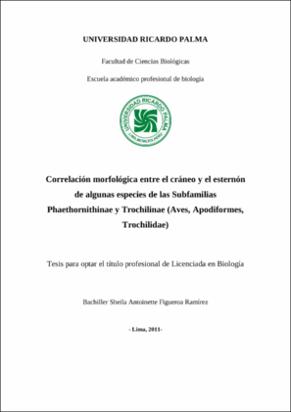Mostrar el registro sencillo del ítem
Correlación morfológica entre el cráneo y el esternón de algunas especies de las Subfamilias Phaethornithinae y Trochilinae (Aves, Apodiformes, Trochilidae)
| dc.contributor.advisor | Morales Mondoñedo, Victor Raúl | |
| dc.contributor.author | Figueroa Ramírez, Sheila Antoinette | |
| dc.date.accessioned | 2017-05-31T16:15:14Z | |
| dc.date.available | 2017-05-31T16:15:14Z | |
| dc.date.issued | 2011 | |
| dc.identifier.uri | https://hdl.handle.net/20.500.14138/906 | |
| dc.description.abstract | El óptimo desarrollo de las adaptaciones para la obtención de los alimentos en los colibríes, se caracteriza por la correlación de sus estructuras morfológicas, las cuales definen así su ecomorfología. Se analizaron algunas medidas morfológicas del cráneo y el esternón de 79 especímenes de colibríes de la subfamilia Phaethornithinae: Phaethornis superciliosus, P. hispidus, P. philippi, P. bourcieri, Eutoxeres condamini, Glaucis hirsutus y Threnetes leucurus y 36 especímenes de la subfamilia Trochilinae: Campylopterus largipennis, Florisuga mellivora, Thalurania furcata, Leucippus chlorocercus y Amazilia lactea, procedentes de la cuenca amazónica peruana; algunos especímenes estuvieron depositados en la colección Ornitológica del Museo de Historia Natural de la Universidad Ricardo Palma (MHNURP-O) (Lima-Perú), otros depositados Centro de Ornitología y Biodiversidad – CORBIDI (Lima-Perú) y otros en el Louisiana Museum of Natural History (LMNHZ) (Louisiana-Estados unidos de Norte América). El Análisis de Componentes Principales de las variables mostró diferencias y similitudes en los índices de correlación entre las medidas del cráneo, del esternón y entre las medidas de estas dos estructuras morfológicas. Así, se evidenció que la variable del ángulo del pico, en Phaethornithinae, está fuertemente correlacionada con las medidas del cráneo, pero no en Trochilinae; en cambio, la variable largo de pico, en Trochilinae, se correlaciono fuertemente con las medidas del cráneo y esternón pero no en Phaethornithinae. Además, Phaethornithinae mostró un alto índice de correlación entre las medidas post-orbital con pre-orbital, pre-orbital con altura de la carina sterni y largo de la base de la carina sterni con ancho de la carina sterni; mientras que, Trochilinae mostró mayor índice de correlación entre post-orbital con inter-orbital, inserción del pico con el ancho del foramen sterni y largo de la base de la carina sterni con ancho de la carina sterni. El análisis de estas variables ayudó a entender las diferencias y similitudes entre ambas subfamilias, así mismo el entorno y rol ecológico para su adaptación.The optimal development of the adaptations of hummingbirds to obtain their food, is characterized by the correlation of their morphological structures, which define their eco-morphology. They were analyzed some morphological measurements of the skull and sternum from 79 specimens of the subfamily Phaethornithinae: Phaethornis superciliosus, P. hispidus, P. philippii, P. bourcieri, Eutoxeres condamini, Glaucis hirsutus and Threnetes leucurus and 36 specimens of the subfamily Trochilinae: Campylopterus largipennis, Florisuga mellivora, Thalurania furcata, Leucippus chlorocercus, and Amazilia lactea, from the Peruvian Amazon, some of which are deposited in the collection of the Museo de Historia Natural de la Universidad Ricardo Palma (MHNURP) (Lima-Peru), others in the Centro de Ornitología y Biodiversidad - CORBIDI (Lima-Peru) and others deposited at the Louisiana Museum of Natural History (LMNHZ) (Louisiana-USA). The ACP of the morphological measurements showed differences between the correlations of the skull and sternum between subfamilies and sexes. The variable angle of bill was the one that strongly influenced the correlations of the others variables of the skull for all the species of Phaethornithinae sub-family but strongly in their females, meanwhile the variable length of bill influenced on the correlations of other variables from the skull and sternum for all the species of Trochilinae sub-family, and the length and angle of bill characterized strongly for their females. Males of both subfamilies were strongly characterized by the sternum measurements, and even they showed strong correlations between the length of the carina sterni basis and its area, indicating that this correlation is a strong characteristic for all the Trochilidae Family.The influence of these variables allowed the development of osteo-morphological differentiation, which were determined by their environment and some other evidences on their ecological role studies. | es_ES |
| dc.description.sponsorship | Submitted by Wong Rafael (rafel_wl@hotmail.com) on 2017-05-31T16:15:14Z No. of bitstreams: 1 Figueroa_sa.pdf: 2412806 bytes, checksum: 7093cddcc65981cf6ce7a725095c7a3e (MD5) | es_ES |
| dc.description.sponsorship | Made available in DSpace on 2017-05-31T16:15:14Z (GMT). No. of bitstreams: 1 Figueroa_sa.pdf: 2412806 bytes, checksum: 7093cddcc65981cf6ce7a725095c7a3e (MD5) Previous issue date: 2011 | es_ES |
| dc.description.uri | Tesis | es_ES |
| dc.format | application/pdf | |
| dc.language.iso | spa | |
| dc.publisher | Universidad Ricardo Palma - URP | es_ES |
| dc.rights | info:eu-repo/semantics/openAccess | |
| dc.rights.uri | https://creativecommons.org/licenses/by-nc-nd/4.0/ | |
| dc.source | Repositorio Institucional - URP | es_ES |
| dc.subject | colibríes | es_ES |
| dc.subject | foramen sterni | es_ES |
| dc.subject | carina sterni | es_ES |
| dc.subject | Campylopterus largipennis | es_ES |
| dc.subject | Florisuga mellivora | es_ES |
| dc.subject | Thalurania furcata | es_ES |
| dc.subject | Leucippus chlorocercus | es_ES |
| dc.subject | Amazilia lactea | es_ES |
| dc.title | Correlación morfológica entre el cráneo y el esternón de algunas especies de las Subfamilias Phaethornithinae y Trochilinae (Aves, Apodiformes, Trochilidae) | es_ES |
| dc.type | info:eu-repo/semantics/bachelorThesis | |
| thesis.degree.discipline | Biología | es_ES |
| thesis.degree.grantor | Universidad Ricardo Palma. Facultad de Ciencias Biológicas. Escuela Profesional de Biología | es_ES |
| thesis.degree.level | Título Profesional | es_ES |
| thesis.degree.name | Licenciada en Biología | es_ES |
| dc.publisher.country | PE | es_ES |
| renati.type | https://purl.org/pe-repo/renati/type#tesis | |
| renati.level | https://purl.org/pe-repo/renati/nivel#tituloProfesional | |
| renati.discipline | 511206 | |
| dc.type.version | info:eu-repo/semantics/publishedVersion |
Ficheros en el ítem
Este ítem aparece en la(s) siguiente(s) colección(ones)
-
Biología [176]


